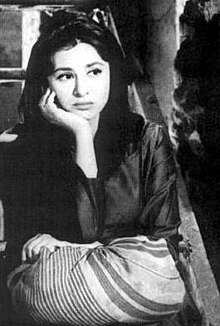Faten Hamama
Faten Hamama , Arabic فاتن حمامة, (* May 27, 1931 in al-Mansura , Egypt ; † January 17, 2015 in Cairo ) was an Egyptian film actress , "a cult star of her country since the late 1940s."
Live and act
The daughter of an employee of the Egyptian Ministry of Education, who was born in northern Egypt near Alexandria, was not even eight years old, and she was in front of the camera for the first time after she had won a children's beauty contest. In 1946, when the family moved to Cairo, her parents decided that she should receive professional acting training, and Faten attended her country's state drama school. Since then she has appeared regularly in front of the film camera. Faten Hamama initially played young girls in melodramas that were based heavily on American models (for example, films with Shirley Temple and Lillian Gish ). “Often she gave the poor and abandoned but adorable girl who had been shaken by fate and who finally caught a glimpse of happiness after many trials and tribulations.” At the end of the 1940s, Faten Hamama was able to assert himself as an adult star in domestic films, the highlight of her Faten Hamama achieved lasting popularity at the beginning of the following decade. The artist was just as successful in dramatic subjects such as Thérèse Raquin in 1951, as well as in musicals (a year later). During this time, they also cast Egypt’s star directors Youssef Chahine and Salah Abu Seif several times .
The merger in front of the camera with the young mime Omar Sharif , who was also Faten Hamama's husband from 1955 to 1974, turned out to be a stroke of luck for both of them to achieve fame in their home country. When, in the course of the 1950s, the film booze, which was particularly popular with the Egyptian audience, was replaced by more realistic material, Faten Hamama was also able to demonstrate her skills as a character interpreter. “With some of her film roles, she promoted a new image of women in Islamic society and encouraged women's emancipation in her country.” Unlike her husband, however, Faten Hamama did not make the leap into international cinema. When the Egyptian secret service urged her to cooperate and she refused to do so, Faten Hamama temporarily left her home in 1966 and did not return until 1971. Since the mid-1970s, the actress has gradually withdrawn from film, but briefly appeared again in front of the camera towards the end of the following decade. Until the turn of the millennium, Faten Hamama occasionally appeared in television productions, after which she withdrew into private life.
Awards
Faten Hamama, whose popularity in the Arab world remained unbroken to the end, although she had not appeared in front of the camera since the beginning of the 21st century, received numerous awards that were presented to her by several domestic and foreign rulers of Arabia. In 1953 she was honored in Lebanon, in 1965 by President Nasser and 1976 by President Sadat , and again in 2001 by the Lebanese head of state and the King of Morocco.
Filmography (selection)
- 1939: Yum sa'id
- 1943: Corsi al ihtiraf
- 1946: Malak al-rahma
- 1948: Nadiya
- 1950: Baba Amin
- 1951: Lak yum ya zalim
- 1952: Mawed mal hayet
- 1953: Deadly Vengeance ( Sira fil-wadi )
- 1954: El malak el zalem
- 1954: Kulub el nass
- 1954: Assar fil rimal
- 1955: Allah maana
- 1955: Mawed times saada
- 1955: Hob wa demui
- 1956: Dark Waters ( Siraa fil mina )
- 1956: Mawed gharam
- 1957: Ard el salam
- 1957: La anam
- 1957: Tarik el amal
- 1958: An Actress's Love ( Hatta nataki )
- 1958: at-Tariq al-masdud
- 1958: Sayedet el kasr
- 1959: Bay al-atlal
- 1959: Nahr el-hob
- 1961: There was a witness ( Lan aataref )
- 1961: La totfi el schams
- 1962: al-moegitza
- 1963: No time for love ( La wakta lel hob )
- 1963: al-bab al maftuh
- 1965: Sin ( Al-haram )
- 1965: al-ataref
- 1966: Schaj fi hayati
- 1968: al-hubb alkabir
- 1971: al-Khayt al-rafi
- 1972: Imbraturiyyat min
- 1974: Orid hallan
- 1978: Ualla azae lel sayedat
- 1984: Leilet al quabd al Fatma
- 1988: Youm hilw, youm me
- 1991: Dameer Ablah Hikmat (television multi-parter)
- 1992: Ard el ahlam
- 2000: Wagh el qamar (TV multi-part)
Web links
- Faten Hamama in the Internet Movie Database (English)
- Obituary on yahoo.com
Individual evidence
- ↑ a b c Kay Less : The large personal dictionary of the film . The actors, directors, cameramen, producers, composers, screenwriters, film architects, outfitters, costume designers, editors, sound engineers, make-up artists and special effects designers of the 20th century. Volume 3: F - H. Barry Fitzgerald - Ernst Hofbauer. Schwarzkopf & Schwarzkopf, Berlin 2001, ISBN 3-89602-340-3 , p. 500.
| personal data | |
|---|---|
| SURNAME | Hamama, Faten |
| ALTERNATIVE NAMES | فاتن حمامة |
| BRIEF DESCRIPTION | Egyptian film and television actress |
| DATE OF BIRTH | May 27, 1931 |
| PLACE OF BIRTH | al-Mansura , Egypt |
| DATE OF DEATH | 17th January 2015 |
| Place of death | Cairo , Egypt |


